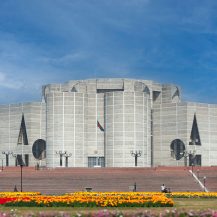The Real Challenge is Taming Inflation Fast
By
Inflation, which is the equivalent of a regressive tax on the poor, accentuates income inequality to make the situation worse.
Inflation is now a problem to be reckoned with. And the poor are bearing the brunt of it. Such inflation could be political dynamite if left untamed. Already, the latest assessment of the Household Income and Expenditure Survey (HIES 2022) showed a significant rise in income inequality, with the Gini coefficient rising to 0.49 in 2022, against 0.45 in 2010, and 0.35 in 1990. Inflation, which is the equivalent of a regressive tax on the poor, accentuates income inequality to make the situation worse.
To be fair, against this dismal backdrop, we must also juxtapose the notable progress in poverty reduction, as the proportion of moderate poor came down to 18.7% in 2022–against 60%in 1990–while the extreme poor decreased to only 5.6%. This means our economic progress has avoided double jeopardy, that is, high inequality plus high and rising poverty.
The International Monetary Fund (IMF) has just come up with its inflation diagnostics. As part of its assessment prior to release of the second tranche of the IMF 42-month programme (which includes Extended Credit Facility and Extended Fund Facility, with about USD 1.4 billion under the Resilience and Sustainability Facility) of USD 4.7 billion, IMF researchers gave us a hefty dose of inflation analytics. In my view, most important is the identification of the source and nature of the problem: the exchange rate pass-through effect on inflation, the standard instruments for curbing it, and the possible timeline for reaching the target level. While shedding enough light on the real cause of the ongoing inflation, the IMF country report on Bangladesh left us with an uncomfortable feeling in saying: ‘Given the lags in monetary transmission, the orderly disinflation process should take several quarters to two years to bring inflation to the target range, unless aided by favourable unexpected shocks.’ The target is apparently 5.5 to 6% inflation, which prevailed prior to the Russia-Ukraine war. The long wait unfortunately is not going to be costless. What about delivering a favourable, unexpected shock?
It is time we start rationalising our tariff structure, not just to make them comparable to those of our peers, but to make our exports more competitive and eliminate the anti-export bias of protection that has currently become a binding constraint for our national imperative of export diversification. The stubborn resistance to lowering or rationalising tariffs is based on the argument that revenue loss goes against the objective of enhancing revenue mobilisation, while domestic industries need protection to survive and prosper.
It is time we start rationalising our tariff structure, not just to make them comparable to those of our peers, but to make our exports more competitive and eliminate the anti-export bias of protection that has currently become a binding constraint for our national imperative of export diversification.
Inflation in Bangladesh was triggered by two simultaneous events in 2022: the supply chain disruption of the Russia-Ukraine war, which caused a spike in commodity prices (particularly for food, fuel, and fertiliser); and the sharp depreciation of the taka against the US dollar (which approximated to 30% as of September 2023). Though international commodity prices abated somewhat, the second-round effects of the two triggers are incurring their impacts. The 50% hike in fuel prices by the government in August 2022 did not help, either. General inflation is running at a tad below 10%, with food inflation at over 12%.
It is now clear that inflation in Bangladesh was induced primarily by cost-push factors. The impact of supply chain disruption and exchange rate depreciation was a supply shock that triggered inflation, which was reinforced by monetary expansion. The latter has now been reversed by Bangladesh Bank through the standard prescription of monetary contraction and interest rate hikes. Also, the tendency to finance the budget deficit by borrowing from BB (which is pure inflationary money creation) has been suspended since July 2023. A neutral fiscal policy is expected to limit the monetisation of the fiscal deficit to keep inflation at bay.
In Bangladesh’s context, the preceding standard prescription may only restrict demand but does not do anything to counter the supply shock emanating from import price hike and taka depreciation. Indeed, the severe import compression imposed on the economy by BB is likely to raise import costs (driven by scarcity), thus becoming an additional cost-push factor of inflation over time.
One particular trigger of inflation which needs to be seriously examined is the massive exchange rate depreciation. This has upset the cart of macroeconomic stability like no other event in my memory. Understanding the mechanism of exchange rate pass-through to inflation is critical for addressing the challenge at hand. The extent and periodicity of such pass-through depend on the economic environment that prevails, such as the degrees of i) exchange rate flexibility, ii) import penetration and share of imports in the domestic market, iii) competition or monopolistic structure in the domestic economy, iv) prevailing trade openness, and v) public intervention in markets. As was evident, the speed of transmission or pass-through was almost contemporaneous and significant. The substantial triggering of inflation, prompted by the massive depreciation, sustains inflation as no compensating countermeasures are in sight or discussed.
One particular trigger of inflation which needs to be seriously examined is the massive exchange rate depreciation. This has upset the cart of macroeconomic stability like no other event in my memory. Understanding the mechanism of exchange rate pass-through to inflation is critical for addressing the challenge at hand.
So, how much of Bangladesh’s inflation is caused by the pass-through? From May 2022 to September 2023, the depreciation of the taka against the US dollar was approximately 30%. Given that Bangladesh is a small economy when it comes to its import share on the world market, it is a pure price taker facing a horizontal import supply curve. Domestic prices reflect import prices, converted to taka using the exchange rate plus any trade taxes. This results in a one-to-one rise in domestic prices corresponding to any rise in import prices, including any spike caused by exchange rate depreciation. However, the impact on overall price level (inflation) will depend on the degree of import penetration (share in GDP), import share in the domestic market, and share of imported inputs in domestic production. Using an applicable model, the IMF did a rigorous exercise to determine the precise degree of exchange rate pass-through and found that, of Bangladesh’s nearly 10% inflation, as much as 5% could be accounted for, directly or indirectly, by the exchange rate depreciation. 
If that is the case, then what is the panacea? The IMF’s ECF-EFF-RSF programme is largely focused on enhancing domestic resource mobilisation. As such, it is silent on the matter of prevailing high trade taxes which account for some 29% of the National Board of Revenue’s tax revenue. What is missing is any guidance regarding the changing composition of trade versus domestic taxes. The challenge of enhancing domestic resource mobilisation entails augmentation of direct domestic taxes, such as income and corporate taxes as well as the value added tax, while gradually reducing reliance on trade taxes. Furthermore, revenue augmentation has to be done by expanding the tax base rather than by raising any rates, as a matter of principle.
Trade taxes (that is, tariffs and para-tariffs), considered the most distortionary taxes in public finance literature, primarily have two objectives: i) to raise revenue; and ii) to offer protection to domestic industries. Raising tariff rates yields higher revenue up to a point (called the optimum rate) beyond which revenue yield declines (as imports fall) but protection continues to rise.
Bangladesh’s average tariffs, at 27.6%currently, is higher than the average of Low-income countries (9.79%), Lower middle-income countries (7.2%), High-income countries (2.02%), and the world average of six percent.
It is time we started rationalising our tariff structure, not just to make them comparable to those of our peers, but to make our exports more competitive and eliminate the anti-export bias of protection that has currently become a binding constraint for our national imperative of export diversification. The stubborn resistance to lowering or rationalising tariffs is based on the argument that revenue loss goes against the objective of enhancing revenue mobilisation, while domestic industries need protection to survive and prosper.
This is where our current tariff structure presents a uniquely Bangladeshi opportunity to counter the inflationary pass-through effect of depreciation, through an approach that can be described as ‘compensated depreciation.’ Rather than let the exchange rate pass-through have an unabated impact on inflation, it can be countered with a reduction in tariffs. A depreciation of the exchange will have the effect of raising tariffs across the board by exactly the percentage increase in the assessable value of imports. In this case, the 30%depreciation of taka may result in a 30% rise in the value of imports. Even if the tariff rate remains unchanged, the higher import value now yields 30% more revenue from the same ad valorem tariff rate.
That is a bonus for NBR. Why? Without actually raising rates, revenue yields rise due to an increase in import value post-depreciation.
Just as the exchange rate depreciation has a pass-through effect on domestic prices (in the form of inflation), so does any change in the tariff rate. As such, a negative pass-through trigger on inflation could be induced by a reduction in tariffs. If not the entire 30% depreciation, at least a partial remission in inflation could be induced by lowering some tariffs or para-tariffs—a case of compensated depreciation. This could be one of IMF’s ‘favourable unexpected shocks’ that could be delivered before or in the forthcoming national budget.
One low-hanging fruit is the three-percent regulatory duty (RD) imposed on nearly half of all imports. Depending on how deep and how fast the government would like to see inflation tamed, the removal of RD could be associated with removing or setting various caps on supplementary duty (SD). These adjustments would incur negative pass-through triggers on inflation, just as the exchange rate depreciation triggered higher inflation in the first place.
To conclude, a downward shock to inflation could be brought about by a downward tariff adjustment. Any downward tariff adjustment would partly neutralise the price or inflationary impact of depreciation, swiftly and sharply. This would be a radically and uniquely Bangladeshi approach to counter the inflationary impacts of depreciation—if the objective is to tame inflation swiftly and sharply—without us having to wait for two years.
The argument that tariffs cuts will cause loss of revenue is not valid in this case as all tariffs have increased by 30% due to taka depreciation. Furthermore, using exchange rate depreciation as a strategy for revenue mobilisation cannot be a valid tax effort. Simultaneously, the basic principle of effective protection tells us that the depreciation has raised effective protection by 30%, since both input and output tariffs have risen in tandem. Thus, neither the revenue nor the protection arguments hold water. Besides, import compression applied for the past year will soon have to be lifted as that policy is slowing down production activities and causing more pain than is necessary. Rising imports should yield more revenue for the NBR over the next few months.
Tariff remission of 5 to 10 to 15% (from existing rates) will have an immediate effect on domestic prices of imports as well as import substitutes and costs of production. This is one great opportunity to remove RDs as an emergency measure to control inflation. More downward adjustments in tariffs and para-tariffs could and should be done in the national budgets for 2025 and 2026, as part of the tariff rationalisation initiatives stipulated in the National Tariff Policy 2023. These measures are consistent with the need to get our overall tariff structure to be World Trade Organization-compliant as we approach 2026, the year of our graduation from LDC status.





